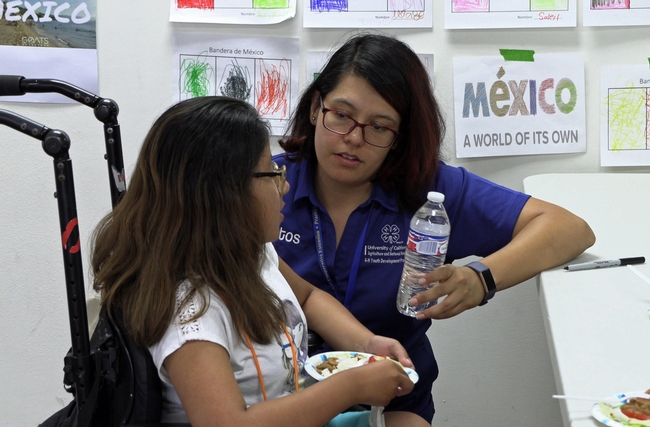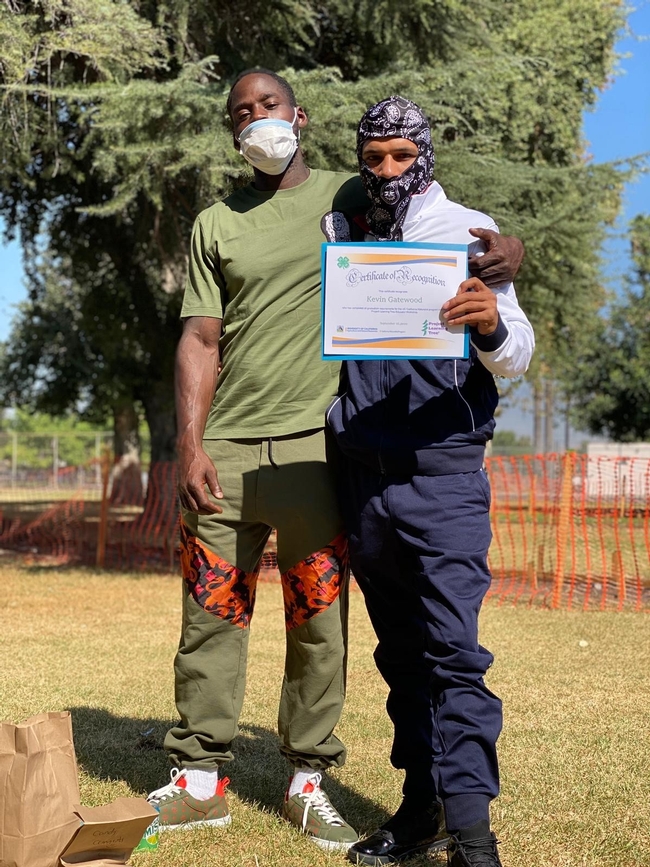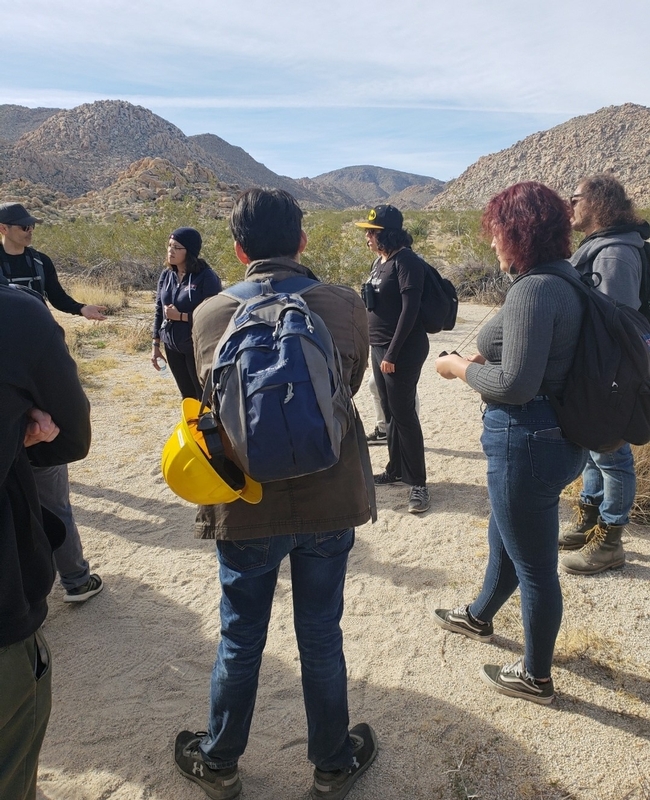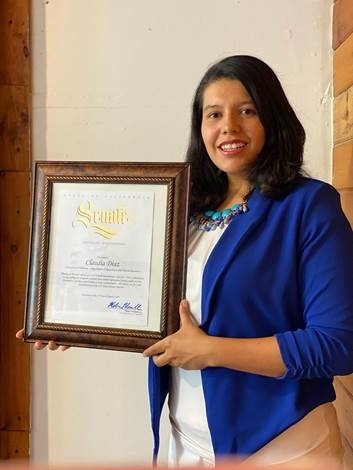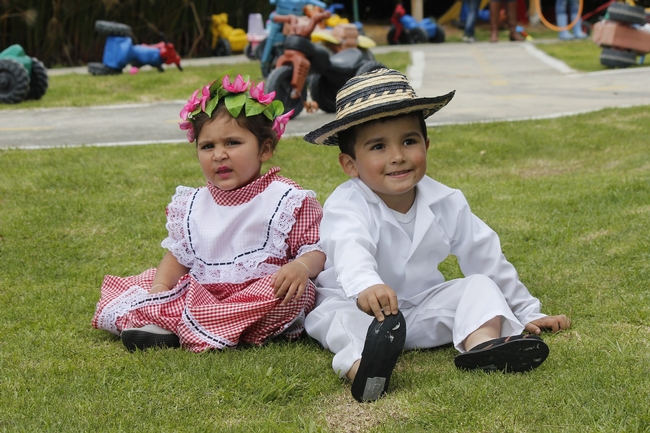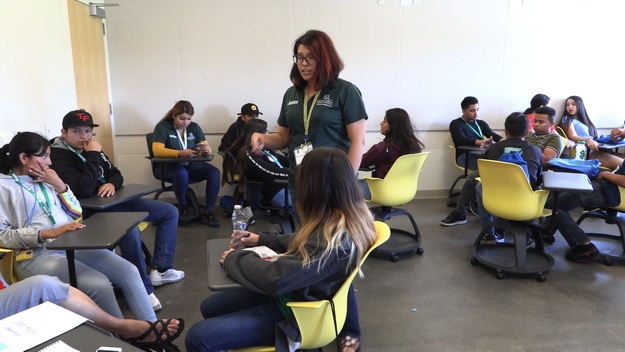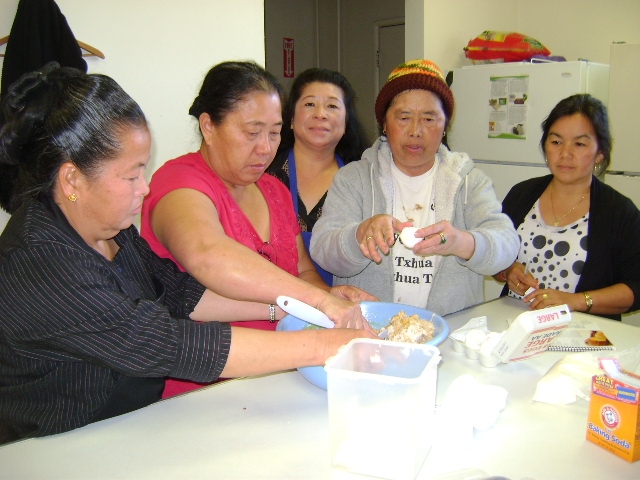Posts Tagged: Claudia Diaz Carrasco
New guides for engaging Latinx youth published
A series of ANR publications have been developed for people who wish to engage Latinx youth and families in their programs.
These briefs were inspired by a research project and the Journal of Youth Development article Guiding Principles for Reaching and Engaging Latinx Youth in Youth Development Programs, by Fe Moncloa, Nancy Erbstein, Aarti Subramaniam and Claudia Diaz Carrasco.
“We know that, in general, youth-serving practitioners do not read journal articles so we used the information to write easy-to-read briefs,” said Moncloa, UC Cooperative Extension 4-H youth development advisor in Santa Clara County.
The brief ANR publications are authored by Moncloa and Claudia Diaz Carrasco, UCCE 4-H youth development advisor in Riverside and San Bernardino counties.
The five-part series are
Engaging Latinx Youth: https://anrcatalog.ucanr.edu/pdf/8690.pdf
Conceptual Foundations: https://anrcatalog.ucanr.edu/pdf/8691.pdf
Organizational Infrastructure: https://anrcatalog.ucanr.edu/pdf/8692.pdf
Program Elements: https://anrcatalog.ucanr.edu/pdf/8693.pdf
Building Relationships in Latinx Communities: https://anrcatalog.ucanr.edu/pdf/8694.pdf
Introducing Latinx youth to the science behind Southern California’s natural wonders
As a child, Sandra Bonilla had a strong connection with the natural world, however, when she grew up and began introducing people of color from Southern California's poorest neighborhoods to local mountains and forests, she said they felt marginalized.
“Almost immediately I saw the outdoor showcased as place for white privilege families, and those of us with colorful backgrounds were not welcomed,” Bonilla said. “As time went on, I realized that my own people were no longer being connected to nature and that our youth had no idea what was camping, or hiking or just enjoying the flight of birds through the top of Jeffrey Pines.”
Bonilla founded the Southern California Mountains Foundation Urban Conservation Corps of the Inland Empire. The program offers young men and women paid work in environmental conservation on meaningful projects where they develop skills that increase job readiness.
To further enhance the educational aspect of the program, the conservation corps partnered with UC Agriculture and Natural Resources (UC ANR) California Naturalist and 4-H Youth Development programs to train a group of corps members to become certified naturalists as part of a unique cohort called Los Naturalistas.
With funding from the National Forest Foundation, UC Cooperative Extension 4-H Youth Development advisor Claudia Diaz Carrasco and conservation corps staff members Gaby Nunez and Lizzet Pineda met with the cohort every Saturday for four months to coordinate presentations by the U.S. Forest Service, CalFire and other professionals and to cultivate an appreciation for the beautiful natural resources that surround their community. The group also gathered for weekly cafecitos, early morning study sessions that helped all the participants get through the training materials together.
Translated materials, creative teaching methods, a diverse expert speaker pool, and incorporation of the strengths the students bring to the table ensured that the cohort received training that was culturally relevant. All 12 emerged as Los Naturalistas, ready to make positive changes in environmental justice and access to public spaces for their communities through nature and Spanish-language interpretation.
“I give thanks to people such as Fabian Garcia, USDA Forest Service; Henry Herrera, CalFire; and Claudia Diaz, UC Agriculture and Natural Resources, who are making new career pathways for Latinos, African Americans, Native Americans and Asian Americans and are ensuring that programs such as Los Naturalistas are changing the color of green outdoor spaces,” Bonilla said.
Diaz Carrasco's involvement in the movement was sparked by an early-career research project funded by UC ANR to identify the most effective ways to reach Latinx communities.
“We found out it's best to go through organizations that are already connected with youth and families,” Diaz Carrasco said.
To learn how to encourage families and youth to participate, engage and stay involved over time, she interviewed leaders of organizations serving this population.
“We were able to identify 25 guiding principles for successful engagement with Latinx families and youth,” she said. “Things like creating a positive ethnic identity, responding to economic poverty, including families and communities, and recruiting culture brokers help build bridges. A lot of these concepts guided the development of Los Naturalistas.”
(For more on the guiding principles for reaching and engaging Latinx youth in youth development, see https://jyd.pitt.edu/ojs/jyd/article/view/19-14-02-FA-03)
The Southern California Mountains Foundation Urban Conservation Corps was a natural partner. They had a diverse corps membership and sought educational opportunities to complement the job skills their corps were gaining through field work.
“Los Naturalistas is a college-level course. You need to do the homework. You need to do the reading. When they get their certification, the participants learn that they can be successful in a college course,” Diaz Carrasco said.
With renewed confidence, the newly minted Naturalistas are encouraged to complete their high school diplomas and enroll in community college classes. They are also charged with completing volunteer time in natural stewardship, education and service. One way they can do that is by sharing their experiences and offering nature instruction to younger members of their communities.
“Instead of me directly reaching the youth, I was able to train corps members to generate interest in California's natural world and the career opportunities available to people who pursue an education. The crew is helping me hit my target audiences,” Diaz Carrasco said. “Part of my work in UC ANR is to mix science and culture. If don't do this work, there are few bilingual people who are able to teach this.”
Claudia Diaz Carrasco applies science and 4-H principles to create youth leaders in under-represented communities
Claudia P. Diaz Carrasco's passion for science started when she was a little girl. She thanks her parents for allowing her to experiment and think out of the box, two concepts that she values dearly.
"I guess the fact that my parents told me whatever I set on my mind I would be able to achieve set me up for success," Diaz Carrasco stated. "Once I enrolled in Food Science Engineering, I loved school so much that when I was done with that degree, I pursued two more."
UC Agriculture and Natural Resources (UC ANR) is committed to developing an inclusive and equitable society by reaching all segments of the state's population. On the front lines building trust and credibility are professionals who bring their unique skills, passion and commitment to make California a better place.
"The most rewarding is the opportunity to build bridges between the university's research-based programs and our local communities. When they do not fit, I have fun creating new programs or adapting from what we do have. I do believe science mixed with traditional knowledge has an infinite power to change people's lives," said Diaz Carrasco.
A native of Atizapán de Zaragoza, México, Diaz Carrasco has been part of UC ANR since 2015 as Youth Development Advisor focusing on Latino and /or low-income youth and families. She faces many cultural and economic challenges to achieve her mission; thanks to her tenacity, dedication and hard work, she and her team have turned their goals into a reality.
"When I joined ANR, there were really few people in the state and around the country doing work intentionally with Latino youth development and 4-H," she said.
Since joining 4-H, she has been instrumental in increasing Latino participation in 4-H programs statewide. Her geographical area of work is the Inland Empire, which includes Riverside and San Bernardino counties. These are two of California's largest counties, with almost 5 million residents, and 65% are Latino.
"About 60% of school-aged youth in Riverside and San Bernardino are Hispanic/Latino," said Diaz Carrasco. "Since the beginning, the primary focus of my position is to develop, implement, evaluate, strengthen and expand local 4-H programming to serve the current under-represented population better."
In an environment that is generally not friendly to changes and challenges, Diaz Carrasco faces a daily array of obstacles to achieving her goal. Among them are high levels of poverty in the families she serves, high crime rates in some communities, and a lack of interest from the parents, who in most cases work two or three jobs to make ends meet.
"The success of my work as the University of California Cooperative Extension (UCCE) advisor relies on how effective my extension team and I can be in sharing knowledge. We have gained this knowledge through research, education, program evaluation, and transfer these into the communities we serve in ways that are relevant for their day-to-day lives while embracing their cultural context," said Diaz Carrasco.
The knowledge that Diaz Carrasco and her team bring directly to the youth, their families, and communities in the Inland Empire creates positive changes and healthier lives. "The way we educate the public matters, and who are our educators matters. Science and culture are at the core of every program we have implemented since I started," she said.
She gives two reasons why her work is penetrating the thick layers of the communities she serves. The first is that she is an immigrant, like many of the families she works with. "I approach my work knowing that a lot of people are going or have gone through the same process I went through in 2014."
Diaz Carrasco also cites thinking out of the box as a reason for success. "I believe creativity and flexibility are at the core of any programs I develop," she stated.
For example, Diaz Carrasco and her team partnered with the Mexican Consulate in San Bernardino, where they held a successful summer camp and strengthened the partnership with the Consulate. Youth could participate in this unique program that aims to help them embrace their Mexican identity, even when, in some cases, they or their parents cannot travel outside the U.S.
The summer camp program was designed to increase positive ethnic identity, and to provide youth development reflecting the Latino and immigrant youth experience and the physiological and social effects of discrimination. The program also responded to economic challenges by assisting families with transportation, providing snacks, and in some cases other items such as toothbrushes, water bottles, or connecting families to health and food agencies. "Above all, we hold the camp in a place that the families were already familiar with and felt safe. This place was the Consulate!" said Diaz Carrasco. "Yes, we turned their art gallery, where official agreements are signed, into a playground. That is what I mean by out of the box,” she added.
The program's interest was visible from day one; in a matter of hours, they reached 100% of the participant count. In the end, the parents expressed their gratitude for offering the programs in an accessible way.
Thinking out of the box has also allowed Diaz Carrasco to partner with major companies in Southern California to benefit the youth.
In five years, she has increased 4-H membership in her area from 667 to 6,021. The overall percentage of Latino youth in 4-H went from 28% to 85%, and the number of volunteers grew from 175 to 354.
Diaz Carrasco measures her success by the words of Sofia, a Moreno Valley student and one of the participants to the 4-H Juntos conference: "Juntos 4-H provides a home and a place where you can safely feel like it is your community. I hope expanding the program gives more students, not only myself but an identity also as to what the community is like and that there are people that care for them and have someone to relate and trust."
Diaz Carrasco has a straightforward message to all those girls who contemplate the idea of getting into the sciences: "My success in science has more to do with resilience than with knowledge. So, the ultimate thing is to pick something you like, have fun doing it and find people around you that also like it or are willing to support you when things get hard."
Why we celebrate Hispanic Heritage Month
Hispanic Heritage Month begins on September 15 and continues until October 15. The purpose of the celebration is to recognize the contributions and vital presence of Hispanics and Latin Americans in the United States.
President Lyndon Johnson first approved Hispanic Heritage Week in 1968 and expanded to a full month by President Ronald Reagan in 1988. Finally, Hispanic Heritage Month was officially enacted as a law on August 17, 1988.
Why is Hispanic Heritage Month held from mid-September to mid-October? It was chosen in this way to reserve two significant dates for Spanish-speaking countries. On the one hand, Independence Day is celebrated in countries such as Mexico, Chile, and five Central American nations (Guatemala, Honduras, Nicaragua, El Salvador, and Costa Rica).
Also, Columbus Day or Día de la Raza was commemorated, a date celebrated more by Italian-Americans than Spanish-speaking immigrants.
Hispanics and Latinos in the United States are getting stronger every day; it is undeniable. But they are more recognized for their culinary richness and the attractiveness of their rhythms, such as Mariachi, salsa, cumbia, mambo, and merengue, than for their essential contributions the professional level. Although, at the national level, there are all kinds of professionals who, with their work, have contributed to the cultural, social, and economic wealth of this country.
Hispanics who have helped improve our lives range from an astronaut to a winner of the Nobel Prize in Physics.
Luis Walter Alvarez, born in Mexico and naturalized American, was an experimental physicist, inventor, and professor who was awarded the Nobel Prize in Physics in 1968.
Franklin Ramón Chang Díaz is a Costa Rican mechanical engineer, naturalized American, physicist, and former NASA astronaut.
Ellen O. Ochoa is an engineer born in Los Angeles, CA, to Mexican parents, who became the first Hispanic woman to travel to space and was a former director of the Johnson Space Center.
Did you know that, according to the Census Bureau, there are 60 million Hispanics in the country? And that more than half live in three states: California, Texas and Florida? Two-thirds of Hispanics in the United States have their origins in Mexico, followed by Puerto Rico (9.5%) San Salvador (3.8%), and Cuba (3.6%). The rest come from the twelve countries where Spanish is the official language.
According to the Census Bureau, college enrollment has increased over the past decade, and 49% of Hispanic high school graduates enrolled in a university. The U.S. Department of Education recognizes six University of California campuses as institutions serving Hispanic students, including UC Irvine, while UC Merced is one of the universities in the country with the highest percentage of Hispanic students.
UC Agriculture and Natural Resources joins the celebration
This year UC ANR the celebration by recognizing three Latino professionals who serve their communities while always upholding UC ANR's public values of academic excellence, honesty, integrity, and community service.
Claudia Diaz - 4-H youth development advisor for Riverside and San Bernardino counties. Claudia has received numerous awards and recognitions for her work with underprivileged youths in urban areas. She has been with UC ANR for five years.
Sonia Ríos - Subtropical horticulture advisor for Riverside and San Diego counties. Since an early age, Sonia knew her future was in agriculture, her grandfather and her father worked in agriculture and taught her the love for nature and the fields. She has been with UC ANR for almost nine years.
Javier Miramontes - Nutrition program supervisor for Fresno County. Javier enjoys the opportunity his work gives him to serve the community where he grew up. He finds it very rewarding to teach parents, senior citizens, and Highschool students about the importance of a healthy diet and how to create a sustainable environment. He has been with UCANR for over five years.
UC ANR educators work to develop an inclusive and equitable California
Both women face many cultural and economic challenges to achieve their missions, and thanks to their tenacity, dedication and hard work, they have turned their goals into a reality.
Claudia P. Diaz Carrasco, a native of Atizapán de Zaragoza, State of México, has been part of UC ANR since 2015 as Youth Development advisor focusing on Latino and/or low-income youth and families.
“When I joined ANR, there were really few people in the state and around the country doing work intentionally with Latino youth development and 4-H,” said Diaz-Carrasco.
Since joining 4-H, Diaz-Carrasco has been instrumental to increasing Latino participation in 4-H programs. She works in the Inland Empire, which includes Riverside and San Bernardino counties — two of the largest counties in California, with almost 5 million residents; 65% are Latino.[i]
“About 60% of school-aged youth in Riverside and San Bernardino are Hispanic/Latino,” said Diaz-Carrasco. “Since the beginning, the primary focus of my position has been to develop, implement, evaluate, strengthen and expand local 4-H programming to serve the current under-represented population better."
In an environment that is generally not friendly to changes and challenges, Diaz-Carrasco faces a daily array of obstacles to achieve her goal. Among them are high levels of poverty among the families she serves, high crime rates in some communities, and a lack of interest from the parents, who in most cases work two or three jobs to make ends meet.
“The success of my work as the University of California Cooperative Extension (UCCE) advisor relies on how effective my extension team and I can be in sharing knowledge gained through research, education and program evaluation, and transferring it to the communities we serve in ways that are relevant for their day to day lives while embracing their cultural context,” said Diaz-Carrasco.
The knowledge that Diaz-Carrasco and her team bring directly to the youth, their families and communities in the Inland Empire creates positive changes and healthier lives.
“The way we educate the public matters, who are our educators matters. Science and culture are at the core of every program we have implemented since I started,” Diaz-Carrasco said.
Diaz-Carrasco gives three reasons why her work is penetrating the thick layers of the communities she serves. The first one is that she is an immigrant, like many of the families she works with day in and day out. “I approach my work, knowing that a lot of people are going or have gone through the same process I went through in 2014.”
She also cites thinking out of the box as another reason for her success. “I believe creativity and flexibility are at the core of any programs I develop.”
To exemplify this statement, Diaz-Carrasco and her team partnered with the Mexican Consulate in San Bernardino, where they held a successful summer camp and strengthened the partnership with the Consulate. Youth were able to participate in this unique program that aims to help them embrace their Mexican identity, even when in some cases they or their parents cannot travel outside the US.
The summer camp program was designed to increase positive ethnic identity, and to provide youth development reflecting the Latino and immigrant experience and the physiological and social effects of discrimination. The program also responded to economic poverty by assisting families with transportation, providing snacks and in some cases other items such as toothbrushes, water bottles or connecting families to health and food agencies. “Above all, we held the camp in a place that the families were already familiar with and felt safe, the consulate!” said Diaz-Carrasco. “We turned their art gallery, where official agreements are signed, into a playground. That's what I mean by out of the box.”
The interest in the program was visible from day one. In a matter of hours, 100% of the participants were reached. In the end, the parents expressed their gratitude for offering the programs in an accessible way.
Thinking out of the box has also allowed Diaz-Carrasco to partner with major companies in Southern California for the benefit of the youth.
In five years, Diaz-Carrasco has been able to increase 4-H membership in her area from 667 to 6,021. The overall percentage of Latino youth in 4-H went from 28% to 85%, and the number of volunteers grew from 175 to 354.
In the words of Sofia, a Moreno Valley student and one of the participants in the 4-H Juntos conference, “Juntos 4-H provides a home and a place where you can safely feel like it is your community. I hope expanding the program gives more students an identity as to what the community is like and that there are people who care for them and have someone to relate to and trust.”
In the heart of California's Central Valley, far from the busy streets of the Inland Empire, almost 100,000 ethnic Hmong call communities like Merced and Fresno home. This community has grown from 1,800 in April of 1982 to nearly 95,000 in 2019.[ii]
UC ANR has supported the Hmong communities in diverse areas, from farming to nutrition. For the past 34 years, Sua Vang, Community Health Education Specialist with the Expanded Food and Nutrition Education Program (EFNEP), has been educating these communities on the value of healthy eating.
“In 1986, I first moved in from San Diego, and I was looking for a job. My husband happened to be a community aid specialist for low family aid,“ said Vang. “So the EFNEP program asked to have two nutrition educators for this position, he happened to be there, I happened to be looking for a job, and I got hired.”
Tens of thousands of Fresno County families have benefited from her nutrition lessons during three decades of bringing healthy habits to Hmong families. Vang has faced a lot of cultural problems while doing it.
“When we go to recruit for our nutrition program, the husband has to approve it and sometimes the husband does not give his support,” said Vang. “It doesn't matter if the wife would like to take the class.”
Cultural eating habits are also a big challenge, obstacles she has overcome with patience, tenacity and creative thinking. “People from Southeast Asia don't eat or drink milk a lot,” she said. “I introduce the almond milk and rice milk so that even if they have lactose intolerance, they can still have milk and calcium in their diet.”
Vang speaks four languages: Hmong, Lao, Thai and English. She has used different platforms to bring the nutrition programs to the Hmong communities, from churches to private homes to classrooms to airwaves. Vang stresses how challenging recruiting new participants to the nutrition classes has become through the years. The older generation of Hmong don't want to go out of their homes and the new generation, said Vang, are more interested in making money than living a healthy life. But she has a pitch for them. “I say to them, if you have a lot of money and your health is not doing well, you have diabetes, and you are dying out, who is going to spend that money?”
Considering that participants in Vang's nutrition classes are immigrants from countries where food safety and nutrition are not part of their daily eating habits, the impact of her classes within the Hmong community is impressive. 73% of participants have improved in one or more food safety practices. Eighty-nine percent have improved in other areas, like reading nutrition labels and ensuring children eat a healthy breakfast.
“Thanks to this career, I would say that I have helped a lot of people, and I am glad. I know my family, my children are doing good, they eat healthily and they are doing good," Vang said. “I make a lot of new friends. I am delighted knowing that I help them.”
[i] 2010 US Census
[ii] 2010 US Census

